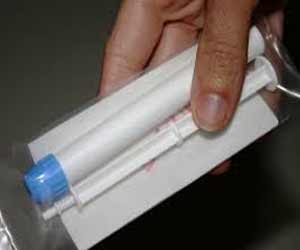- Home
- Editorial
- News
- Practice Guidelines
- Anesthesiology Guidelines
- Cancer Guidelines
- Cardiac Sciences Guidelines
- Critical Care Guidelines
- Dentistry Guidelines
- Dermatology Guidelines
- Diabetes and Endo Guidelines
- Diagnostics Guidelines
- ENT Guidelines
- Featured Practice Guidelines
- Gastroenterology Guidelines
- Geriatrics Guidelines
- Medicine Guidelines
- Nephrology Guidelines
- Neurosciences Guidelines
- Obs and Gynae Guidelines
- Ophthalmology Guidelines
- Orthopaedics Guidelines
- Paediatrics Guidelines
- Psychiatry Guidelines
- Pulmonology Guidelines
- Radiology Guidelines
- Surgery Guidelines
- Urology Guidelines
Daily use of tenofovir gel may prevent genital herpes in women

The researchers examined the effect of vaginal tenofovir 1 per cent gel use on the risk of acquiring herpes simplex virus type 2, or HSV-2 and found the results. The study was conducted through a secondary analysis of data from the VOICE study, the primary results of which were published in 2015.
The paper has been published in the Journal of Infectious Diseases.
The recent study findings also align with the results of CAPRISA 004, a previous tenofovir gel study on HSV-2 acquisition reduction. The CAPRISA 004 study tested gel application strictly within 12 hours before and after vaginal intercourse.
“Women are especially susceptible to infection because it is more easily transmitted from an infected man to his female sex partner than vice versa,” said corresponding author Jeanne Marrazzo, M.D., director of the Division of Infectious Diseases at the University of Alabama at Birmingham. “A product that protects against HSV-2 could have an important public health impact.”
According to the Centers for Disease Control and Prevention, more than one in six Americans ages 14 to 49 are infected with genital herpes. HSV-2 infection is the most common cause of genital herpes and also enhances the risk of acquiring and transmitting HIV. No vaccine currently exists for HSV-2.
Of the 566 HSV-2-negative participants, Marrazzo and her colleagues found that overall use of vaginal tenofovir 1 per cent gel was associated with a 40 per cent reduction of HSV-2 acquisition. Over the follow-up period, 92 new cases of HSV-2 occurred, with 77 in women with no plasma tenofovir detected and 15 with plasma tenofovir. Tenofovir measured in plasma was used as a measure of gel use.
Marrazzo’s study reanalyzed data collected in the VOICE study, now specifically looking at the subgroup of women that adhered to daily gel usage and their rate of HSV-2 acquisition relative to women who did not adhere to gel usage.
In the original VOICE study, investigators studied HIV-1 pre-exposure prophylaxis in reproductive-age women in South Africa, Uganda and Zimbabwe. Participants were asked to regularly use study products, including vaginal tenofovir 1 per cent gel, but adherence was low.
“While both studies focus on the same product, our study is distinct in various ways, such as the emphasis on daily usage,” Marrazzo said. “With our new findings, we can pay more attention to studying products combining tenofovir with other preventive materials in order to protect against HSV-2 and HIV — addressing both infections with multipurpose prevention products will maximize protective impact for women.”

Disclaimer: This site is primarily intended for healthcare professionals. Any content/information on this website does not replace the advice of medical and/or health professionals and should not be construed as medical/diagnostic advice/endorsement or prescription. Use of this site is subject to our terms of use, privacy policy, advertisement policy. © 2020 Minerva Medical Treatment Pvt Ltd